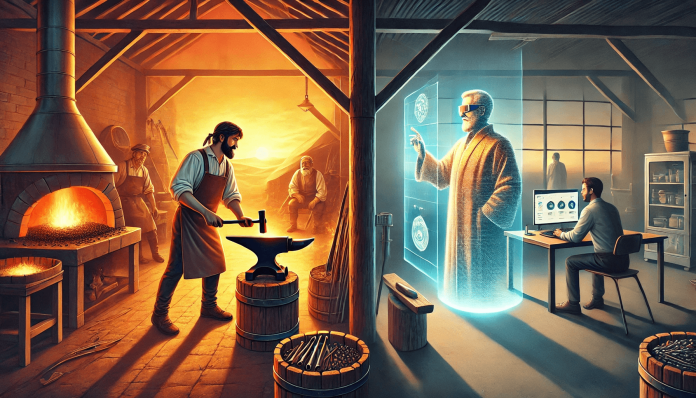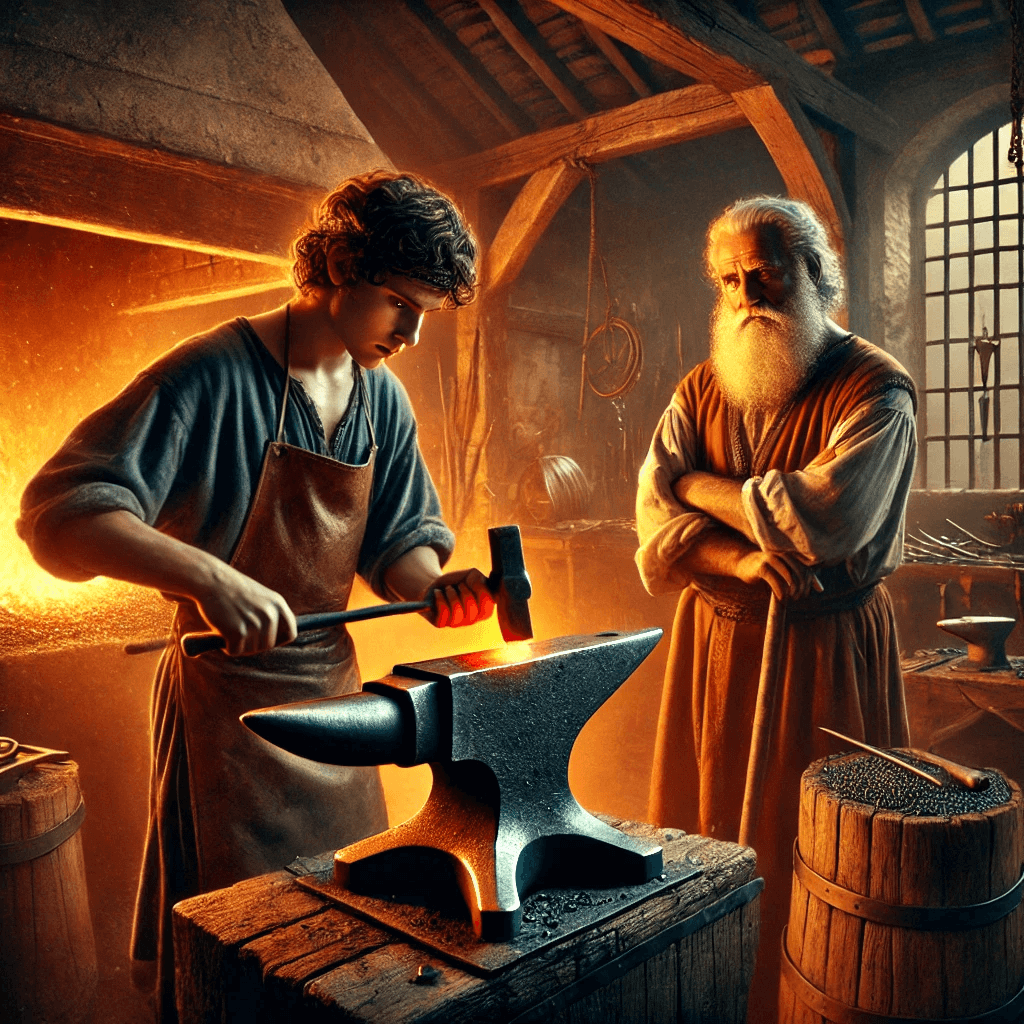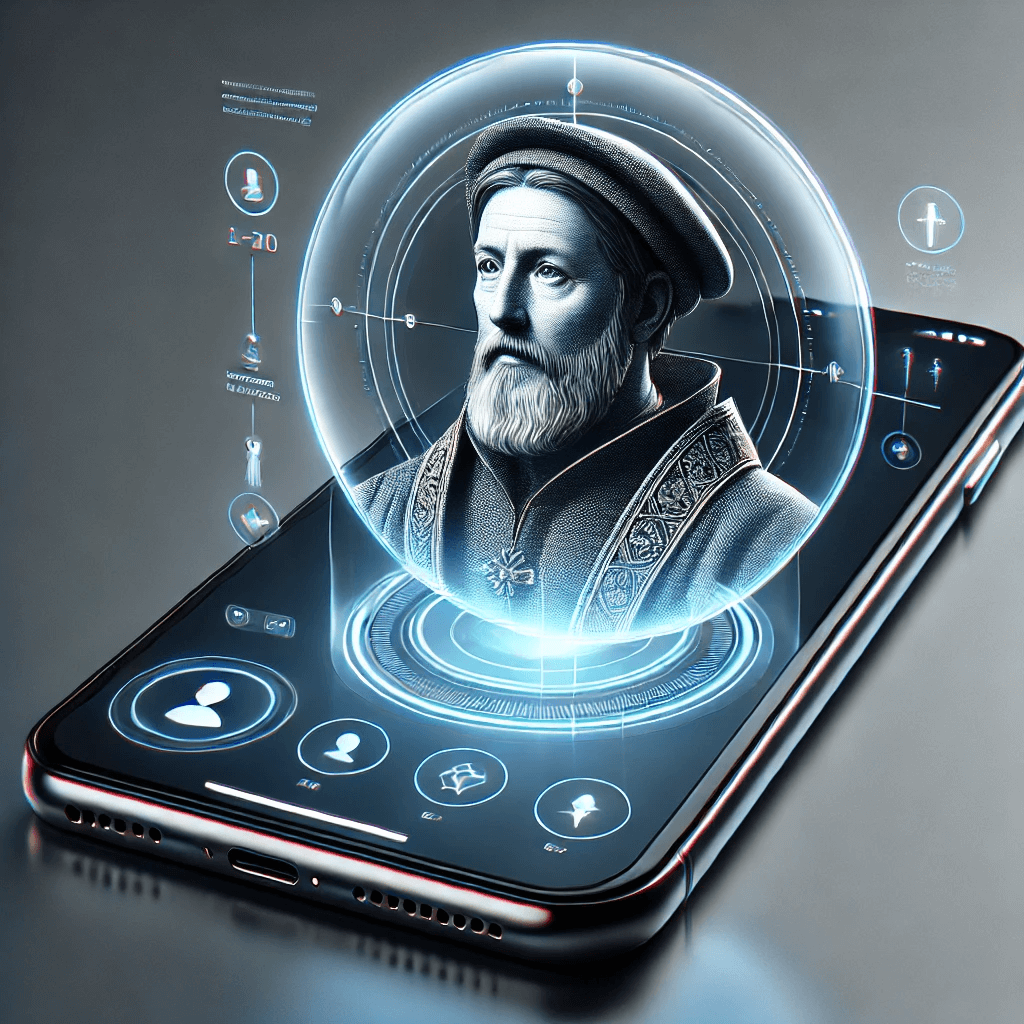
In 14th-century Florence, a young apprentice hammers iron at the local Blacksmiths’ Guild, his master—his coach—guiding every sweaty swing toward mastery.
Today, coaches are digital: Employees tap Slack, and artificial intelligence (AI) delivers lessons instantly.
What’s the link? Let’s explore how history’s wisdom and modern systems supercharge scalable, personal training that sticks.
The Timeless Power of Guild Training
In medieval guilds, apprenticeships were built around clear roles and immersive, hands-on learning. Young apprentices lived and worked alongside a master craftsman, hammering iron and honing skills through the daily grind—learning by doing.
Roles were clear: novice to expert, with real-time guidance and tailored lessons at the appropriate pace, progressing from basic tasks to sophisticated mastery only when ready.
Centuries later, these core principles remain remarkably relevant: Practice beats theory, expert feedback accelerates growth, and personal progression trumps one-size-fits-all.
Effective training has always been practical and responsive. The guilds’ wisdom never faded, but it did wait for modern tools to scale it across today’s workforce.

Today’s Challenges and the Pitfalls of Centralized Training
Even top-tier learning and development (L&D) teams often find themselves limited by outdated systems—chained to centralized content and content pipelines that can’t keep up. It’s costly, rigid, and churns out one-size-fits-all content that leaves learners dozing, not growing.
Worse, it lags behind job demands that shift faster than a TikTok trend. A franchisee once told Beeline, “My training’s so stale, it’s like sending carrier pigeons in the WhatsApp era.”
Centralized systems bottleneck progress, bleeding budgets and morale. Yesterday’s rigid playbook can’t match today’s pace—39 percent of workers’ core skills will transform by 2030 (WEF).
There’s an exciting opportunity for L&D to evolve into a more strategic corporate function, steering competence and ROI within their organizations.
Democratized Authorship—The Game Changer
What if teams and managers built their training?
That’s democratized authorship leapfrogging bottlenecks and delivering lessons and knowledge that hit home.
It used to be too much effort; most managers did not have the time or skills (instructional design—learning science) to do it effectively. Artificial Intelligence changes that—instantly transforming managers’ subject matter expertise into highly effective, pedagogically sound training.
Managers and team leaders are “closest to the metal” regarding their people and what they need to know and improve at; they are, in some sense, the “Masters” of their guilds.
L&D professionals then become the guild’s directors, enabling, equipping, and aligning this distributed coaching network with company-wide goals.
Take DISA, a healthcare innovator training international distributors on a flagship medical device. DISA’s product team built tailored, interactive modules packed with multimedia content.
The result? Swift, personalized learning. Distributor training time plummeted, and new hires hit proficiency milestones 50 percent faster.
It’s scalable, guild-style skill transfer: practical, personal, and powered by today’s tools — proof the old blueprint still works when you hand the hammer to the team.
“The training program we developed and launched together was one of the past year’s highlights. It’s made a real impact on our business.”
— Lisa Blatch, Product Development, DISA
Enter AI—A Personal Trainer in Every Pocket
AI enables and turbocharges democratized authorship, turning managers into guild masters with a digital edge.
It scans performance reviews, market shifts, and even a manager’s grumbled “needs work,” spotting competency gaps in real time. Bite-sized, conversational lessons hit Slack or Microsoft Teams—no training room needed—coaching you to mastery on the job.
Take Huru: Beeline certified 1,815 workers in three months, slashing errors by 30 percent. “Suddenly, we’re training 200 a day, not five,” their team lead marveled.
Stats back it up: Analysts estimate that by 2025, more than 50 percent of digital work will be supported by AI like this. It’s guild wisdom at scale—swift, personal, and practical—cutting central bloat while boosting grit.
AI isn’t replacing trainers. It’s giving them superpowers—freeing them to focus on strategy, coaching, and creativity while the system handles the rest.

Timeless Lessons for Modern Leaders
Guilds taught us what sticks:
Lesson 1: Hands-on beats handouts
Learning sticks when you’re swinging the hammer—not reading about it. Prioritize experiential learning over passive content.
Lesson 2: Tailored beats generic
Match lessons to the immediate needs of your team and their changing roles.
Lesson 3: Ownership sparks mastery
Decentralize training creation. When managers shape learning, their teams naturally invest more energy, creativity, and ownership.
These aren’t relics but proven lessons from history’s playbook, now turbocharged with modern breakthroughs.
Back to the Future—Guild Wisdom Meets AI
That Florence apprentice, sweating under his master’s eye? His guild spirit lives on—effective training has always been about guidance, context, and craft.
From the guild masters of old to today’s Learning leaders, what’s changed is not the role but the reach. AI doesn’t replace the trainer; it turns every employee into an apprentice with access to world-class mentorship—at scale.
The most significant breakthroughs reinvent the past—so, L&D leaders, will your team hammer out what’s next? Blend the old with the bold and build a thriving workforce. What a time to be alive!


